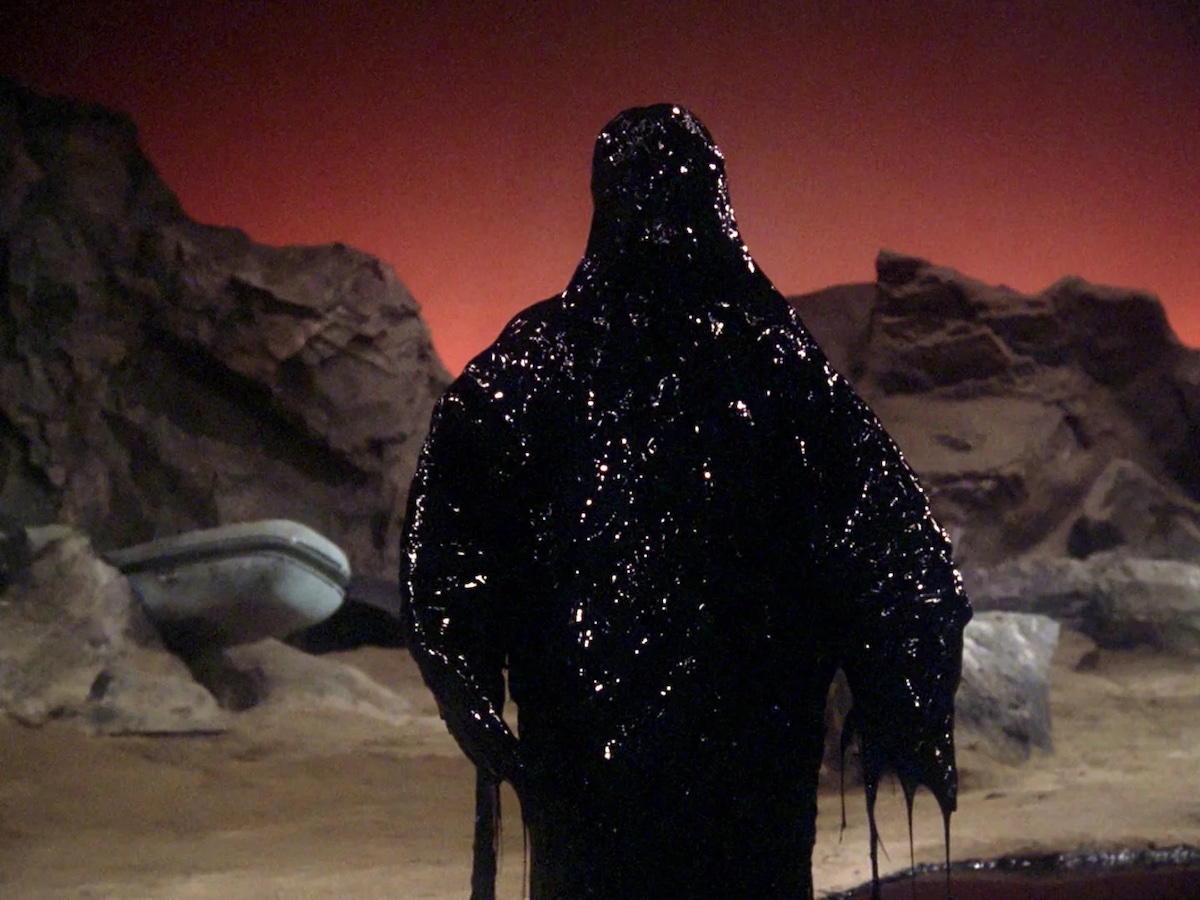“Au revoir, Natasha.”
I never saw “Skin of Evil” in its original run, which I guess is just as well, although it did result in me tuning in for the second season of Star Trek: The Next Generation and wondering, “Where’s Tasha?” like a dumb kid whose parents were lying to him about the disappearance of the dog. I came in to TNG during the re-runs of the first season, and somehow skipped over “Skin of Evil” completely, in spite of seeing both “We’ll Always Have Paris” (my first!) and “Symbiosis.” And somewhere in the middle, Tasha died.
Alongside Dr. Crusher, Tasha was ostensibly my favourite character in Season One, although – as I’ve discussed previously – it’s not like the character was ever given any great breadth of development. Further, I can heartily agree that the Season One Enterprise bridge was top-heavy with characters, and at least one had to go – and in looking at what the Season One survivors brought to the rest of the series, I can’t argue with the decision (mutual between Crosby and the producers) to nix Tasha. But losing her – and Beverly! – in one stroke? Sorta broke my 12-year-old heart, back in the day.
Roddenberry’s creative decision – to kill Tasha quickly, without fanfare, as a chilly reminder of the dangers of Starfleet’s mission – remains scintillating. Where “Skin of Evil” of course falls down are its legendarily poor production values: a cardboard planet set, which would be bad enough… and then, the monster. Armus, the walking oil slick who is an autonomous manifestation of the negative attributes of a long-lost species of titans who left him behind, is actually an intriguing science fiction notion, but holy cow, he is managed so poorly here that it’s a wonder the cast can keep straight faces in their scenes with him. The physical production of “Skin of Evil” adds great insult to the injury of losing Tasha, and rubs salt in the wound of what seems to be Roddenberry’s perfunctory offing of her. There are a lot of great ideas in “Skin of Evil” that get completely bumchuggered by their execution; the episode’s sole lasting visual idea (and it’s a beauty) comes when Riker has been absorbed into the creature, and then briefly surfaces in the oil slick, his face a mask of pain.
In spite of the cold efficiency of Tasha’s death, Denise Crosby probably gets more emotional scenes in this episode than in the entire rest of the season – her pre-taped self-eulogy, certainly, but also her nice beat with Worf at the head of the episode. Tasha, like many female characters in science fiction before her, had to die to become a viable character, which is shameful, but a long time ago now; and Crosby was, of course, given the entire series’ greatest grace note with her return appearance in “Yesterday’s Enterprise.”
Taken together, “Symbiosis” and “Skin of Evil” represent a strange running-aground of TNG at the tail of its inaugural season. Other episodes from the final brace – “We’ll Always Have Paris,” “Conspiracy,” and “The Neutral Zone” – demonstrate handily how far the series has come; “Skin of Evil” plays up a fairly clear reminder of just how bad the Star Trek sequel series could have been, had it not gotten its collective shit together. Faint aspects of “Skin” – primarily, the performances of the rest of the crew in response to Tasha’s death, which hits each of them staggeringly hard – augur the wealth of resources that the production team would be able to take into the next season and beyond. Best of all is Troi, who vacillates between grief and tactile rage, suggesting a lot of fire to Marina Sirtis’ performance that was scarcely used in the first season. But perhaps the most startling character beat in the episode comes from Data, who, with dispassion, assesses Armus’ value as a creature, and then pronounces without hesitation: “I think you should be destroyed.”
Star Trek doesn’t do death very well, with the possible exception (immediately reversed) of Spock in Star Trek II. The eulogy sequence at the end of “Skin of Evil” looks awful, thanks to some bad bluescreening, and is oversentimental at the best of times, but it’s amazing how emotionally resonant it can be regardless. If there’s one thing the crew of the Enterprise-D could never be accused of, its overexpressing themselves emotionally. In quietly assessing the crew she’s left behind, Tasha defines each of them in a surprisingly deft, personal way – never more so than when she describes Picard as having “the heart of an explorer and the soul of a poet.” Gets me every time – and then she’s gone.

Blogging The Next Generation is like my first Geocities site back in 1997. With nothing better to do with it, I wrote miscellaneously about Star Trek – now I’m doing that for every single episode of Star Trek: The Next Generation.
This series runs every Tuesday and will do so for the entire release of TNG on blu-ray. Season 2 has been announced for December 4, 2012.
